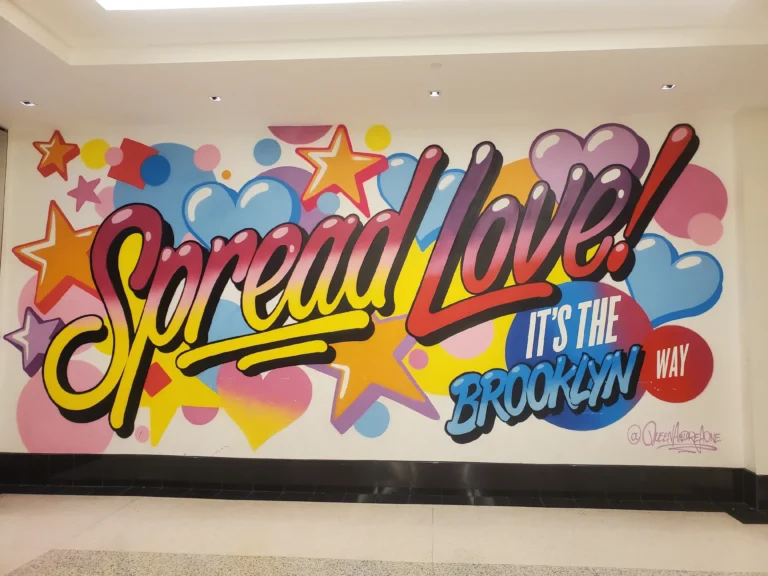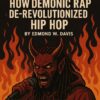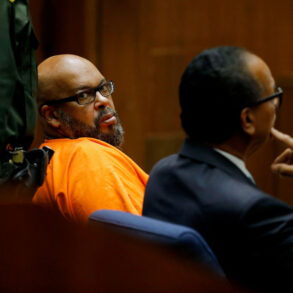Thirty years ago, one of hip-hop’s biggest stars prepared to release his debut album. Biggie Smalls, The Notorious B.I.G, or Biggie, whichever nomenclature most suits you, had recorded one of the most important and influential albums of not only his era, but in hip hop and music history. As rap music began to take its place as part of mainstream culture, there was no telling what would follow with the release of Ready to Die on September 13, 1994.

Now, a full three decades later, it’s impossible to ignore the impact of Biggie’s only non-posthumous release. For a Brooklyn native, Biggie’s music is ever-present; blasting through the speakers of passing cars, in stores, and especially at parties (even now, no party is complete without a splash of “Warning” or “Mo Money Mo Problems”).
In Brooklyn, Biggie’s impact is found everywhere. You won’t get too far without seeing a mural dedicated to him. From East New York to Bay Ridge to Caroll Gardens, his face is plastered on walls, t-shirts, and merchandise in almost every store, and one of his most iconic (and laughably ironic) quotes from “Juicy” is spray painted everywhere: “Spread love, it’s the Brooklyn way.” Bed-Stuy revels in his impact on hip hop and the borough, as Biggie repped Brooklyn hard. Hence, now the city immortalizes him within the city’s infrastructure, with the city even naming the street he was born on after him. Rappers copied everything he had to offer; his flow, his style, his music subjects. They even would gather an entourage that was similar to Junior M.A.F.I.A., and of course, would copy his “beef” with Tupac.
Biggie’s Legacy
However, his legacy doesn’t stop at street signs and t-shirts or even music itself. The impact of his death (and Tupac Shakur’s) rewrote the rules to which an artist gains mainstream momentum.In the years following his and Tupac’s deaths, listeners were itching for another great conflict, missing the frequent drama and excitement and excellent music it brought. The entertainment of the Bigge-Tupac beef was what plunged rap into the mainstream, and it was only a matter of time before it became a regular aspect of the culture.

Amidst the influx of West Coast success (The Chronic, Doggystyle), Biggie, Nas & Wu Tang helped turn the tide, bringing a certain grit that over produced West Coast beats could not match. After all, Ready to Die was a testament to Biggie’s days as a young hustler just trying to make it big, as he details the life in the streets and the drug game. The album featured artists that would later be leading figures in hip hop, including Diddy, Method Man, and Lil’ Kim. The three singles released in anticipation of the album, “Juicy,” “Big Poppa,” and “One More Chance,” charted on the Billboard Hot 200 and were certified Gold (“Juicy”) and Platinum (“Big Poppa” and “One More Chance”) by the RIAA.

The Aftermath of Ready to Die
The surmounting success of Biggie’s debut implemented a drastic change in the culture’s perception of hip-hop. Rap was now a serious contender in the music industry, developing its own subculture with a discernable music and fashion style. Rappers from both coasts became more present in media, each competing for the top spot in the game; Biggie, Diddy, and Wu-Tang Clan from the East, and Dr. Dre, N.W.A, and Tupac from the West.
But with this emergence, a dark side followed. West Coast rappers were still gaining traction in the scene, battling with East Coast rappers for the top spots on the charts and within the zeitgeist. Biggie’s Ready to Die caused an almost cult-like following to develop in New York, forming the group Junior M.A.F.I.A. soonafter. In November of 1994, just two months after Ready to Die was released, California-based rapper Tupac was shot and robbed at Quad Studios in New York. By the time news of the shooting broke, most people speculated that Junior M.A.F.I.A was behind it, even if the shooters were completely unrelated. But this didn’t stop Pac from publicly pointing the finger at Biggie
Every Man For Himself
The music industry competitive, and there was simply not enough room for every rapper to become mainstream. Thus began an incredibly competitive culture within the genre, constantly pushing each newest member to “pick a side,” both for protection and the advancement of their career.
Within this competitiveness, the culture of “rap beef” became part of the norm for the genre. Rappers were never ones to shy away from expressing their disdain towards their peers.
It was during these three years that rap listeners were taking sides, proving their loyalty to the coasts, and in turn, their leaders. The Biggie vs. Tupac battle was dominating the hip-hop industry, with rappers that weren’t even affiliated with the main rivals picking sides and taking shots at one another.
All of the media attention and perceived beef would eventually lead to the tragically early deaths of both Biggie and Tupac. In September of 1996, Tupac was shot and killed in Las Vegas, when he was only 25. Six months later, in March of 1997, Biggie was shot and killed in Los Angeles at the age of 24.
[embedded content]
Biggie’s Legacy and The Development of Rap Beef
Despite its tragic ending, Biggie and Tupac’s battles were just the beginning of this development in rap culture. Rap music may have lost two of its biggest stars, but that didn’t mean that the competitiveness of the genre was ever going to end. Rap beef was now implemented into the culture and a proven method to generate album sales.
The 2000s saw several incredibly entertaining and fundamental beefs between rappers that really elevated the genre to where it is today; Jay-Z and Nas, 50 Cent and Ja Rule, LL Cool J and Canibus, Nicki Minaj and Lil’ Kim, and so many more went through periods of time throwing shade at, or outright dissing one another on their tracks. For many rappers, their best chance at catapulting their careers was through conflict. 50 Cent became a household name through his feud with Ja Rule. While Nas’ feud with Jay-Z brought out the best out of him.

After the tragic ending of the Biggie and Tupac feud, rap beef became less of a genuine feud and more of a corporate tool to keep hip-hop in the mainstream. There was also this sense that a rap beef would make or break someone’s career. If a rapper admitted to losing their beef, their career was on standby or disappeared completely. Some credit 50 Cent’s endless dissing of Ja Rule led to his demise, while Canibus suffered perceived losses to LL Cool J and Eminem, helping kill his flame.
Hip Hop Bo Longer Jumping
During the last few years, rap has grown stale. The lyrical charm was wearing off, and the idea that rap was “so different” from other kinds of music, what originally made it stand out against pop, rock, and other existing trends, was no longer true. Rap, even though it dominated radio and Billboard charts and popular culture, was no longer something unique and special; rather, it was a pre-packaged, commercialized version of what listeners were getting pre-hip hop.
The genre has been performing poorly on the charts since 2020 after it started to turn to social media platforms like TikTok to advertise. Even if this did help more people reach the genre, it paved the way for thousands of artists to overload the app with their own music, so much so that it all began to blend together, devoid of originality or effort, and more concerned with “blowing up on TikTok” than saying or doing anything truly meaningful or different.
A New Age
The way we listen to music now has also played a major role; before streaming, purchasing physical copies of music meant that you could only choose a few albums at a time, or pick one and stick to it until the next album comes out. Now, we have the largest access to all of the world’s music on streaming services, whether it be Spotify, Apple Music, Soundcloud, or YouTube. Even if a rapper isn’t selling a physical copy of their music, or hasn’t been signed to an actual record label, you can access their music at any point. It’s a double-edged sword: you’re able to gain knowledge of incredible underground talent, but you’re also able to find someone that outshines them in less than ten seconds.
Rap “beef” also took a major turn. Instead of violent threats or disses, the “beef” became more about revealing a rapper’s secrets. We see this especially with the beef between Pusha T and Drake, when Pusha revealed Drake’s secret son in “The Story of Adidon” before Drake had the chance to do the Adidas advertisement with him. There was now a fundamental shift in what rap beef was about; it was no longer a race to the top based on merit or skill, but about character.
Drake v. Kendrick
This brings us to the one and only Drake. Over the course of Drake’s almost two-decade-long career, he has amassed rivals spanning across multiple genres, from The Weeknd, to Pusha T, Kanye West, Meek Mill, to even his own mentor Lil’ Wayne. After all, the rumor mills say that he took music from The Weeknd for his GRAMMY-winning album Take Care and he has ghostwriters. All of these were accusations that would hurt any other rapper’s career, yet Drake was able to stay at the top of the rap game for years afterward. He continued to dominate the charts, and every album he released quickly rose to the top. Rendering impermissible to decline.
That is until Kendrick Lamar reemerged onto the scene. With “Euphoria,” where Kendrick makes scathing accusations over a six-minute track accusing Drake of being a gambler, drug addict, and neglectful father. While also reminding the world of Drake’s not-so-spotless record with women and underage girls.

What Now?
But in an era where hip-hop has become so stale, even the reactions and consequences of a rivalry this intense are stale. The biggest and most impactful consequence of Kendrick’s diss tracks was a crowd of over 20,000 shouting, “Tryna strike a chord and it’s probably A-minor,” at The Pop Out in Inglewood on Juneteenth.
However, there is something different about this rivalry that encompasses what rap beef has become about in the last three decades. It’s no longer a physical game, it’s a mental one. Kendrick did not set out to physically harm Drake in any capacity.
Kendrick’s accusations against Drake, combined with people bumping “Not Like Us” all summer, reveal something to the audience more sinister than violence. This was not a rap beef that was essentially a petty argument about who was “better” Kendrick set out to start and finish this beef by ending Drake’s credibility within hip hop culture. He wants Drake’s impact on rap reversed. In the end, he doesn’t want Drake dead, he just wants Drake gone.

It’s hard to tell whether or not Drake is going to be able to bounce back from the blow of “Not Like Us.” Having crowds of people, including some of the biggest stars and Drake’s own personal idols, singing “You not a colleague, you a f—kin colonizer” will not be easy to retaliate against. Perhaps Drake should listen to “What’s Beef” and take this one on the chin.
[embedded content]
This post was originally published on this site be sure to check out more of their content.






